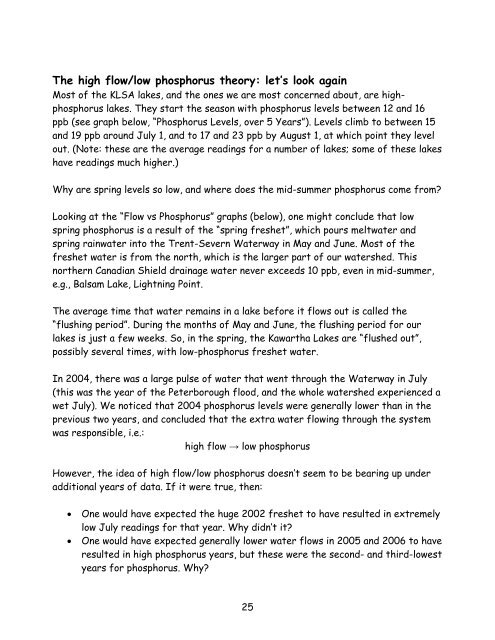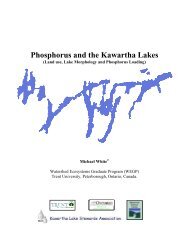Lake Water Quality 2006 Report - Lakefield Herald
Lake Water Quality 2006 Report - Lakefield Herald
Lake Water Quality 2006 Report - Lakefield Herald
You also want an ePaper? Increase the reach of your titles
YUMPU automatically turns print PDFs into web optimized ePapers that Google loves.
The high flow/low phosphorus theory: let’s look againMost of the KLSA lakes, and the ones we are most concerned about, are highphosphoruslakes. They start the season with phosphorus levels between 12 and 16ppb (see graph below, “Phosphorus Levels, over 5 Years”). Levels climb to between 15and 19 ppb around July 1, and to 17 and 23 ppb by August 1, at which point they levelout. (Note: these are the average readings for a number of lakes; some of these lakeshave readings much higher.)Why are spring levels so low, and where does the mid-summer phosphorus come from?Looking at the “Flow vs Phosphorus” graphs (below), one might conclude that lowspring phosphorus is a result of the “spring freshet”, which pours meltwater andspring rainwater into the Trent-Severn <strong>Water</strong>way in May and June. Most of thefreshet water is from the north, which is the larger part of our watershed. Thisnorthern Canadian Shield drainage water never exceeds 10 ppb, even in mid-summer,e.g., Balsam <strong>Lake</strong>, Lightning Point.The average time that water remains in a lake before it flows out is called the“flushing period”. During the months of May and June, the flushing period for ourlakes is just a few weeks. So, in the spring, the Kawartha <strong>Lake</strong>s are “flushed out”,possibly several times, with low-phosphorus freshet water.In 2004, there was a large pulse of water that went through the <strong>Water</strong>way in July(this was the year of the Peterborough flood, and the whole watershed experienced awet July). We noticed that 2004 phosphorus levels were generally lower than in theprevious two years, and concluded that the extra water flowing through the systemwas responsible, i.e.:high flow → low phosphorusHowever, the idea of high flow/low phosphorus doesn’t seem to be bearing up underadditional years of data. If it were true, then:• One would have expected the huge 2002 freshet to have resulted in extremelylow July readings for that year. Why didn’t it?• One would have expected generally lower water flows in 2005 and <strong>2006</strong> to haveresulted in high phosphorus years, but these were the second- and third-lowestyears for phosphorus. Why?25





